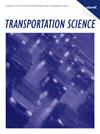Hypercongestion, Autonomous Vehicles, and Urban Spatial Structure
IF 4.4
2区 工程技术
Q1 OPERATIONS RESEARCH & MANAGEMENT SCIENCE
引用次数: 0
Abstract
This paper examines the effects of hypercongestion mitigation by perimeter control and the introduction of autonomous vehicles on the spatial structures of cities. By incorporating a bathtub model, we develop a land use model where hypercongestion occurs in the downtown area and interacts with land use. We show that hypercongestion mitigation by perimeter control decreases the commuting cost in the short run and results in a less dense urban spatial structure in the long run. Furthermore, we reveal that the impact of autonomous vehicles depends on the presence of hypercongestion. The introduction of autonomous vehicles may increase the commuting cost in the presence of hypercongestion and may cause a decrease in the suburban population; however, it may make cities spatially expand outward. This result contradicts that of the standard bottleneck model. When perimeter control is implemented, the introduction of autonomous vehicles decreases the commuting cost and results in a less dense urban spatial structure. These results show that hypercongestion is a key factor that can change urban spatial structures.History: This paper has been accepted for the Transportation Science Special Issue on ISTTT25 Conference.Funding: This work was supported by ACT-X [Grant JPMJAX21AE], Fusion Oriented REsearch for disruptive Science and Technology [Grant JPMJFR215M], the Japan Society for the Promotion of Science [Grants 23K13422 and 22H01610], and the Council for Science, Technology and Innovation [Grant JPJ012187].Supplemental Material: The online appendix is available at https://doi.org/10.1287/trsc.2024.0519 .过度拥堵、自动驾驶汽车和城市空间结构
本文探讨了通过周边控制和引入自动驾驶汽车缓解过度拥堵对城市空间结构的影响。通过结合浴缸模型,我们建立了一个土地利用模型,在该模型中,过度拥堵发生在市中心区域,并与土地利用相互作用。我们的研究表明,通过周边控制缓解过度拥堵会在短期内降低通勤成本,并在长期内降低城市空间结构的密度。此外,我们还揭示了自动驾驶汽车的影响取决于是否存在过度拥堵。在过度拥堵的情况下,自动驾驶汽车的引入可能会增加通勤成本,并可能导致郊区人口减少;但是,自动驾驶汽车的引入可能会使城市在空间上向外扩张。这一结果与标准瓶颈模型相矛盾。当实施周边控制时,自动驾驶汽车的引入会降低通勤成本,并导致城市空间结构密度降低。这些结果表明,过度拥堵是改变城市空间结构的一个关键因素:本文已被 ISTTT25 会议交通科学专刊接受:本研究得到了 ACT-X [JPMJAX21AE], Fusion Oriented REsearch for disruptive Science and Technology [JPMJFR215M], the Japan Society for the Promotion of Science [Grants 23K13422 and 22H01610], and the Council for Science, Technology and Innovation [Grants JPJ012187] 的支持:在线附录见 https://doi.org/10.1287/trsc.2024.0519 。
本文章由计算机程序翻译,如有差异,请以英文原文为准。
求助全文
约1分钟内获得全文
求助全文
来源期刊

Transportation Science
工程技术-运筹学与管理科学
CiteScore
8.30
自引率
10.90%
发文量
111
审稿时长
12 months
期刊介绍:
Transportation Science, published quarterly by INFORMS, is the flagship journal of the Transportation Science and Logistics Society of INFORMS. As the foremost scientific journal in the cross-disciplinary operational research field of transportation analysis, Transportation Science publishes high-quality original contributions and surveys on phenomena associated with all modes of transportation, present and prospective, including mainly all levels of planning, design, economic, operational, and social aspects. Transportation Science focuses primarily on fundamental theories, coupled with observational and experimental studies of transportation and logistics phenomena and processes, mathematical models, advanced methodologies and novel applications in transportation and logistics systems analysis, planning and design. The journal covers a broad range of topics that include vehicular and human traffic flow theories, models and their application to traffic operations and management, strategic, tactical, and operational planning of transportation and logistics systems; performance analysis methods and system design and optimization; theories and analysis methods for network and spatial activity interaction, equilibrium and dynamics; economics of transportation system supply and evaluation; methodologies for analysis of transportation user behavior and the demand for transportation and logistics services.
Transportation Science is international in scope, with editors from nations around the globe. The editorial board reflects the diverse interdisciplinary interests of the transportation science and logistics community, with members that hold primary affiliations in engineering (civil, industrial, and aeronautical), physics, economics, applied mathematics, and business.
 求助内容:
求助内容: 应助结果提醒方式:
应助结果提醒方式:


